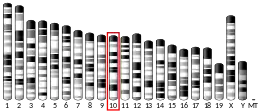| APBA3 | |||||||||||||||||||||||||||||||||||||||||||||||||||
|---|---|---|---|---|---|---|---|---|---|---|---|---|---|---|---|---|---|---|---|---|---|---|---|---|---|---|---|---|---|---|---|---|---|---|---|---|---|---|---|---|---|---|---|---|---|---|---|---|---|---|---|
 | |||||||||||||||||||||||||||||||||||||||||||||||||||
| |||||||||||||||||||||||||||||||||||||||||||||||||||
| Identifiers | |||||||||||||||||||||||||||||||||||||||||||||||||||
| Aliases | APBA3, MGC:15815, X11L2, mint3, amyloid beta precursor protein binding family A member 3 | ||||||||||||||||||||||||||||||||||||||||||||||||||
| External IDs | OMIM: 604262 MGI: 1888527 HomoloGene: 3591 GeneCards: APBA3 | ||||||||||||||||||||||||||||||||||||||||||||||||||
| |||||||||||||||||||||||||||||||||||||||||||||||||||
| |||||||||||||||||||||||||||||||||||||||||||||||||||
| |||||||||||||||||||||||||||||||||||||||||||||||||||
| |||||||||||||||||||||||||||||||||||||||||||||||||||
| |||||||||||||||||||||||||||||||||||||||||||||||||||
| Wikidata | |||||||||||||||||||||||||||||||||||||||||||||||||||
| |||||||||||||||||||||||||||||||||||||||||||||||||||
Amyloid beta A4 precursor protein-binding family A member 3 is a protein that in humans is encoded by the APBA3 gene.[5][6]
Function
The protein encoded by this gene is a member of the X11 protein family. It is an adapter protein that interacts with the Alzheimer's disease amyloid precursor protein. This gene product is believed to be involved in signal transduction processes. This gene is a candidate gene for Alzheimer's disease.[6]
Interactions
APBA3 has been shown to interact with Amyloid precursor protein.[5][7]
References
- 1 2 3 GRCh38: Ensembl release 89: ENSG00000011132 - Ensembl, May 2017
- 1 2 3 GRCm38: Ensembl release 89: ENSMUSG00000004931 - Ensembl, May 2017
- ↑ "Human PubMed Reference:". National Center for Biotechnology Information, U.S. National Library of Medicine.
- ↑ "Mouse PubMed Reference:". National Center for Biotechnology Information, U.S. National Library of Medicine.
- 1 2 Tanahashi H, Tabira T (Apr 1999). "X11L2, a new member of the X11 protein family, interacts with Alzheimer's beta-amyloid precursor protein". Biochem Biophys Res Commun. 255 (3): 663–7. doi:10.1006/bbrc.1999.0265. PMID 10049767.
- 1 2 "Entrez Gene: APBA3 amyloid beta (A4) precursor protein-binding, family A, member 3 (X11-like 2)".
- ↑ Biederer T, Cao X, Südhof TC, Liu X (Sep 2002). "Regulation of APP-dependent transcription complexes by Mint/X11s: differential functions of Mint isoforms". J. Neurosci. 22 (17): 7340–51. doi:10.1523/JNEUROSCI.22-17-07340.2002. PMC 6757996. PMID 12196555.
External links
- Human APBA3 genome location and APBA3 gene details page in the UCSC Genome Browser.
Further reading
- Kuriyan J, Cowburn D (1997). "Modular peptide recognition domains in eukaryotic signaling". Annual Review of Biophysics and Biomolecular Structure. 26: 259–88. doi:10.1146/annurev.biophys.26.1.259. PMID 9241420.
- Morishima-Kawashima M, Ihara Y (2002). "[Recent advances in Alzheimer's disease]". Seikagaku. 73 (11): 1297–307. PMID 11831025.
- Bonaldo MF, Lennon G, Soares MB (1997). "Normalization and subtraction: two approaches to facilitate gene discovery". Genome Res. 6 (9): 791–806. doi:10.1101/gr.6.9.791. PMID 8889548.
- Okamoto M, Südhof TC (1999). "Mint 3: a ubiquitous mint isoform that does not bind to munc18-1 or -2". Eur. J. Cell Biol. 77 (3): 161–5. doi:10.1016/s0171-9335(98)80103-9. PMID 9860131.
- Tanahashi H, Tabira T (1999). "Genomic organization of the human X11L2 gene (APBA3), a third member of the X11 protein family interacting with Alzheimer's beta-amyloid precursor protein". NeuroReport. 10 (12): 2575–8. doi:10.1097/00001756-199908200-00025. PMID 10574372.
- Okamoto M, Nakajima Y, Matsuyama T, Sugita M (2001). "Amyloid precursor protein associates independently and collaboratively with PTB and PDZ domains of mint on vesicles and at cell membrane". Neuroscience. 104 (3): 653–65. doi:10.1016/S0306-4522(01)00124-5. PMID 11440799. S2CID 39280897.
- Wang P, Wang X, Pei D (2004). "Mint-3 regulates the retrieval of the internalized membrane-type matrix metalloproteinase, MT5-MMP, to the plasma membrane by binding to its carboxyl end motif EWV". J. Biol. Chem. 279 (19): 20461–70. doi:10.1074/jbc.M400264200. PMID 14990567.
- Malmberg EK, Andersson CX, Gentzsch M, Chen JH, Mengos A, Cui L, Hansson GC, Riordan JR (2005). "Bcr (breakpoint cluster region) protein binds to PDZ-domains of scaffold protein PDZK1 and vesicle coat protein Mint3". J. Cell Sci. 117 (Pt 23): 5535–41. doi:10.1242/jcs.01472. PMID 15494376.
External links
- PDBe-KB provides an overview of all the structure information available in the PDB for Human Amyloid-beta A4 precursor protein-binding family A member 3 (APBA3)
This article is issued from Wikipedia. The text is licensed under Creative Commons - Attribution - Sharealike. Additional terms may apply for the media files.





